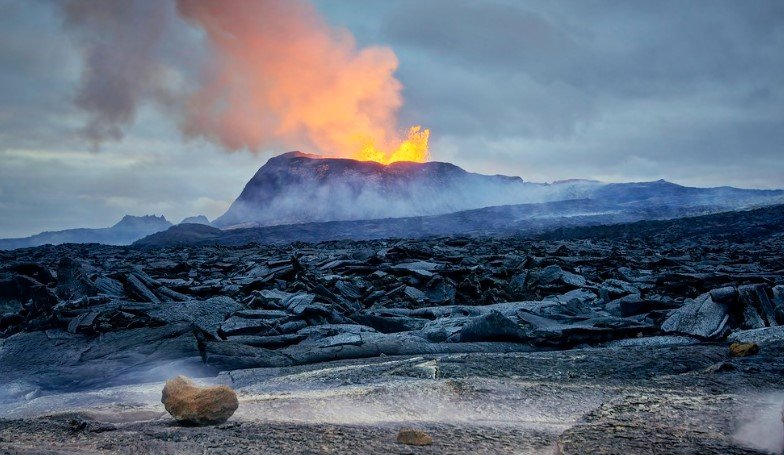After weeks of intense earthquake activity, a volcano erupted on the Reykjanes peninsula of southwest Iceland on Saturday, December 16, 2023. The eruption occurred near the town of Grindavik, where about 4,000 people were evacuated earlier this week. The Icelandic Meteorological Office (IMO) said that the eruption was close to the Fagradalsfjall mountain, about 4 kilometers (2.5 miles) northeast of Grindavik. The fissure, where lava spewed out, was about 500–700 meters (1,640–2,300 feet) long.
The eruption was the first one in the area in nearly 800 years and the first one on the Reykjanes peninsula in more than 6,000 years. The peninsula is located on the Mid-Atlantic Ridge, where the North American and Eurasian tectonic plates are moving apart. The volcanic activity in the region is part of a natural cycle that occurs every few thousand years, according to geologists.
The eruption was not a surprise for the scientists, who had been monitoring the seismic activity in the area since October. They had detected a large intrusion of magma under the Svartsengi geothermal power plant, which had caused the ground to rise by about a centimeter (nearly half an inch) a day. The magma had also formed a vertical dike, or a crack in the crust, that extended for about 14.5 kilometers (9 miles) along the peninsula. The dike was connected to the magma reservoir under Svartsengi and was feeding the eruption.

A spectacular sight
The eruption attracted many curious spectators, who drove to the site to witness the spectacle of lava and smoke. The IMO said that the eruption was small and posed no immediate danger to people or infrastructure. However, it warned that the situation could change quickly and advised people to stay away from the eruption site and follow the instructions of the authorities.
The eruption was also visible from the capital city of Reykjavik, which is about 32 kilometers (20 miles) away from the volcano. Many people took to social media to share photos and videos of the glowing red sky and the lava fountains. Some even compared the scene to the fictional land of Mordor from the Lord of the Rings trilogy.
The eruption also created a stunning contrast with the snow-covered landscape and the northern lights, which were visible in the night sky. The northern lights, or aurora borealis, are caused by charged particles from the sun interacting with the Earth’s magnetic field. They are more common in the winter months when the nights are longer and darker.
A potential impact
While the eruption was not considered a major threat, it could have some impacts on the environment and the economy of Iceland. The IMO said that the eruption emitted a large amount of sulfur dioxide, a gas that can cause respiratory problems and acid rain. The gas could also affect the air quality and visibility in the region, depending on the wind direction and the weather conditions.
The eruption could also affect the tourism industry, which is one of the main sources of income for Iceland. The Reykjanes peninsula is home to many popular attractions, such as the Blue Lagoon geothermal spa, the Krýsuvík geothermal area, and the Bridge Between Continents, where visitors can walk across the rift between the tectonic plates. The eruption site itself could become a tourist attraction, as long as it remains safe and accessible.
However, the eruption could also disrupt the flights to and from Iceland, as the volcanic ash could damage the engines of the airplanes. The IMO said that the eruption produced a small amount of ash, which was not expected to reach high altitudes. However, it cautioned that the ash could increase if the eruption became more explosive or if the wind changed direction. The IMO said that it was working closely with the aviation authorities and the airlines to monitor the situation and provide updates.
The eruption could also have some positive effects, such as providing new scientific data and insights into the volcanic processes and the history of the region. The eruption could also create new landforms and enrich the soil with minerals and nutrients. The eruption could also inspire new artistic and cultural expressions, as volcanoes have long been a source of fascination and inspiration for Icelanders.
Prolonged activity
The IMO said that the eruption was likely to continue for a while, as the magma supply was still high and the pressure was still building up in the crust. The IMO said that it was possible that new fissures could open up or that the eruption could migrate to a different location. The IMO said that it was also possible that the eruption could stop abruptly, as the magma could solidify or find a new path.
The IMO said that the Reykjanes peninsula was entering a prolonged active period, which could last for decades or centuries. The IMO said that the last active period in the region occurred between the 10th and 13th centuries, when several eruptions occurred along the peninsula. The IMO said that the current activity was similar to the beginning of that period and that it could mark the start of a new volcanic era in Iceland.






